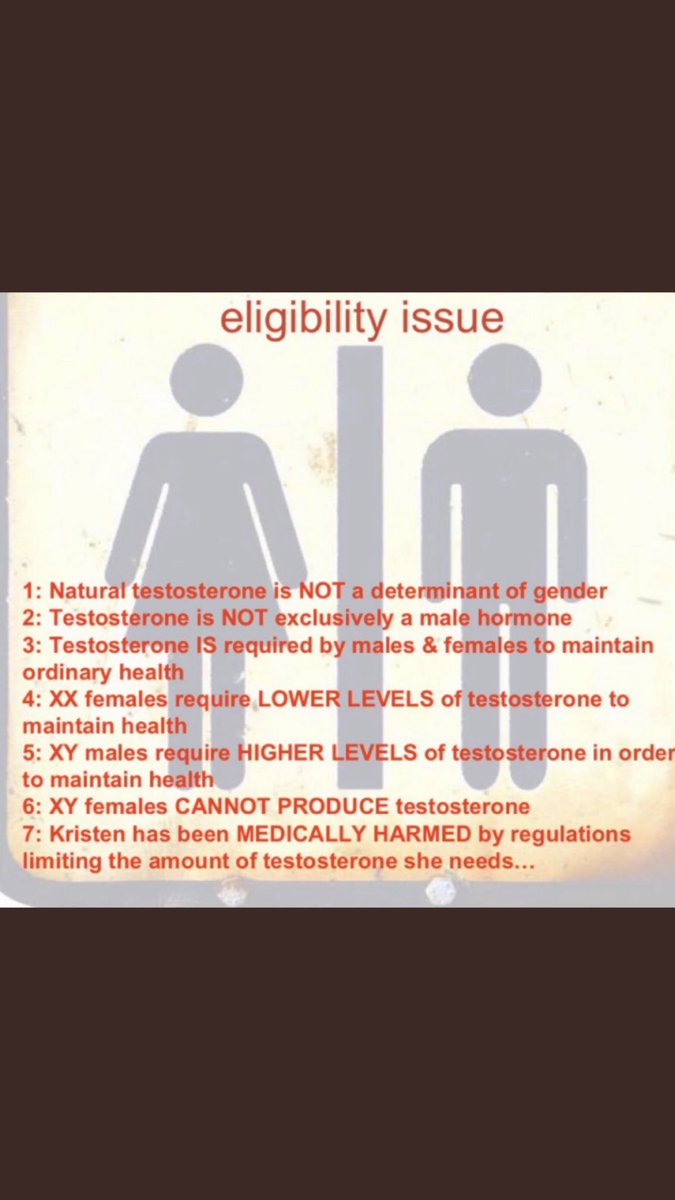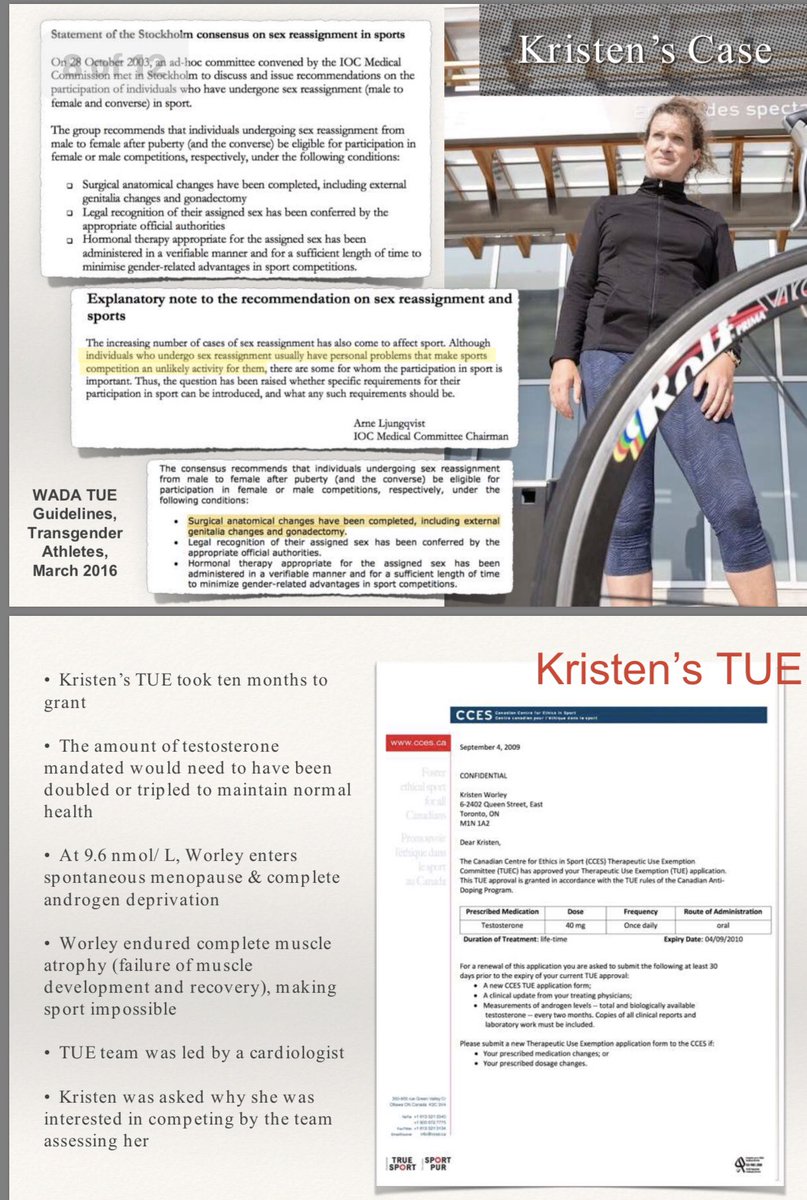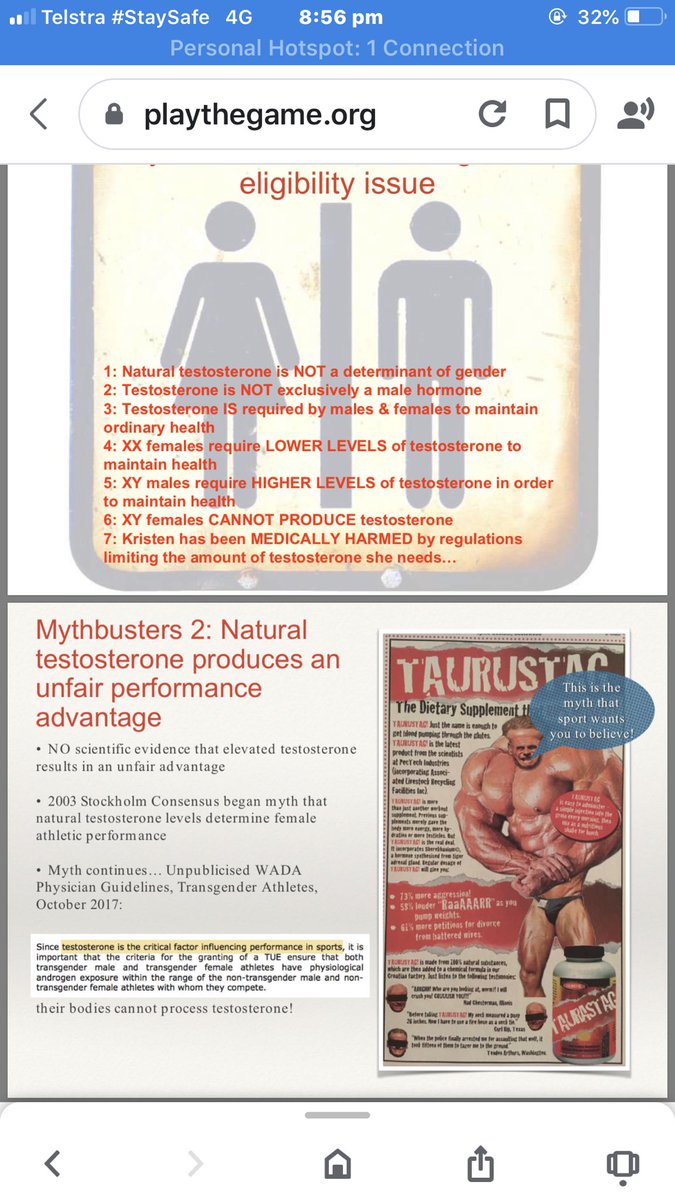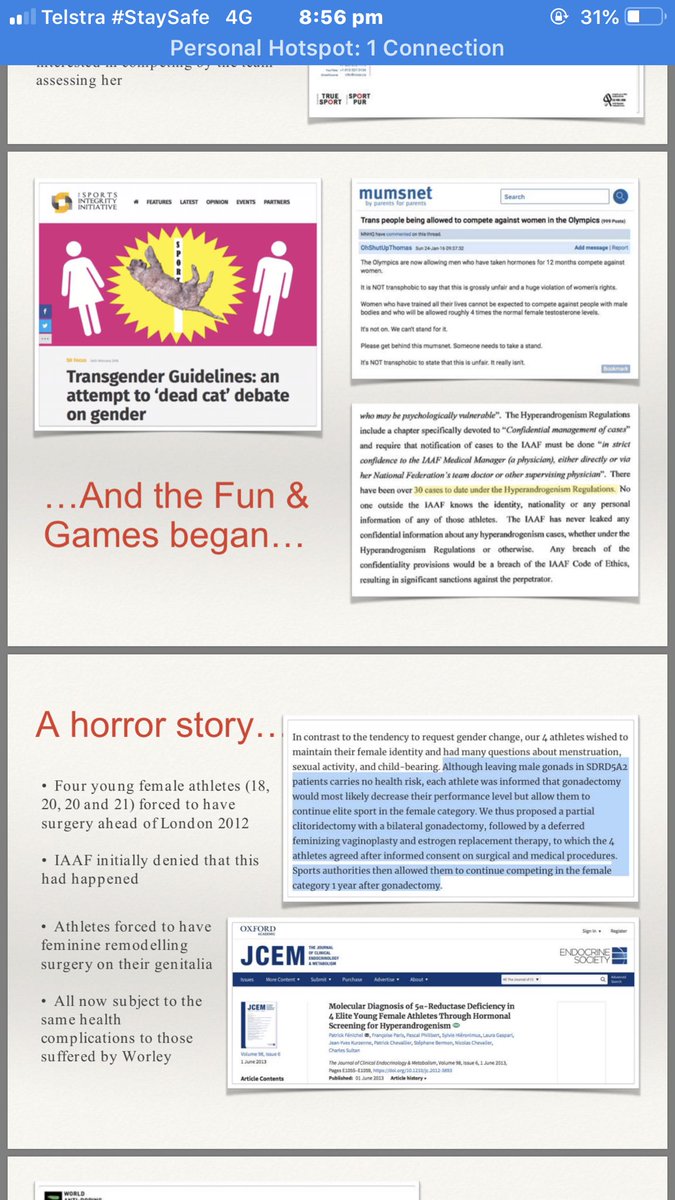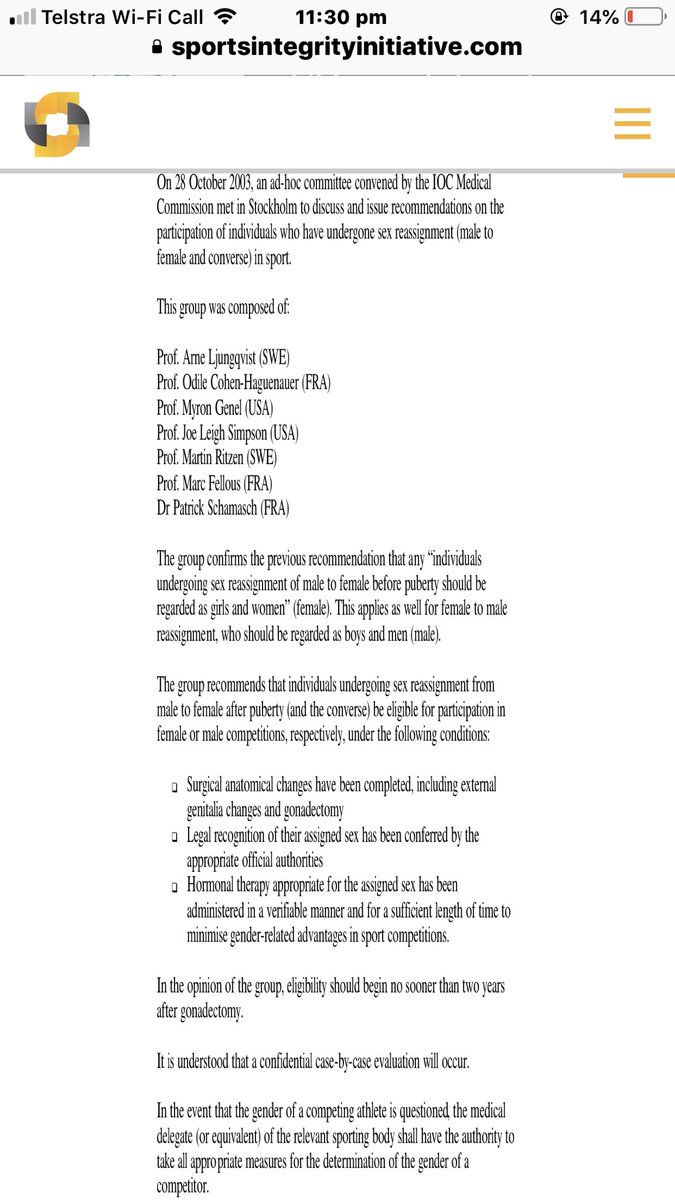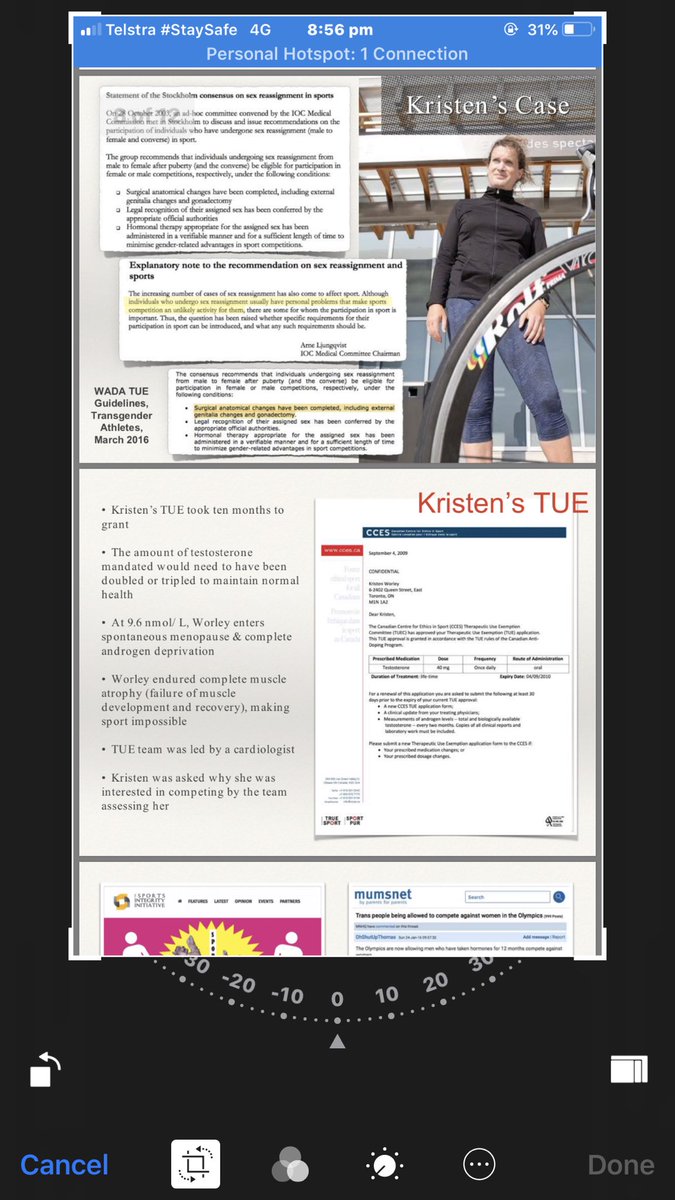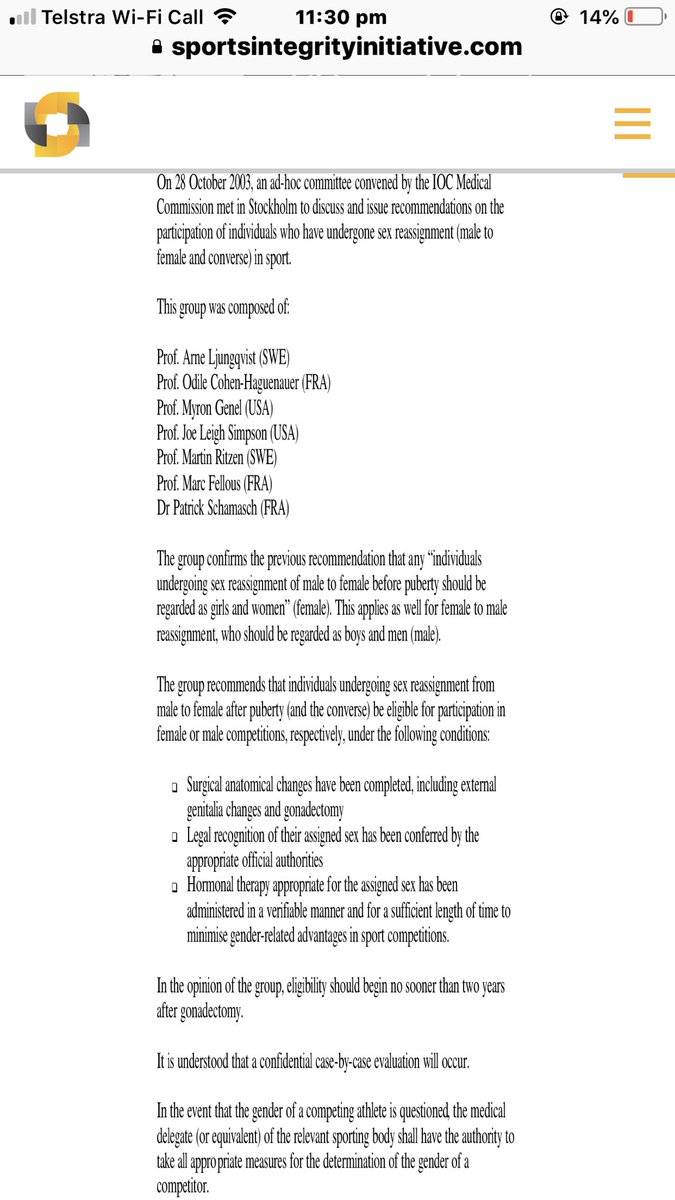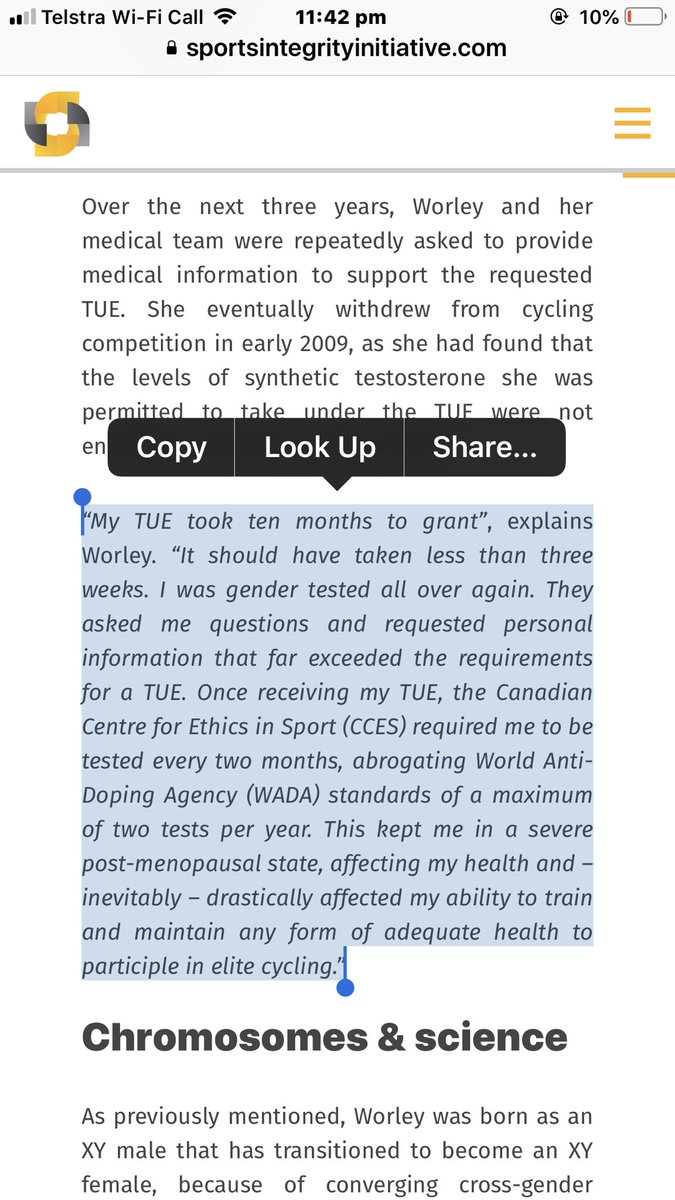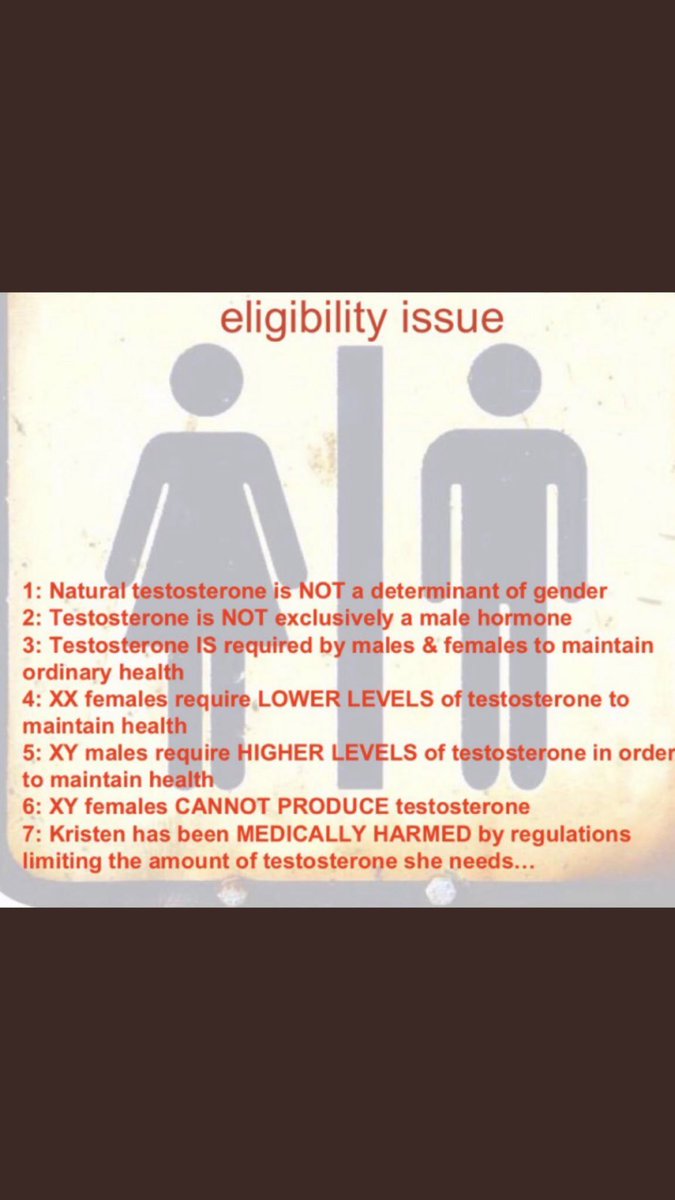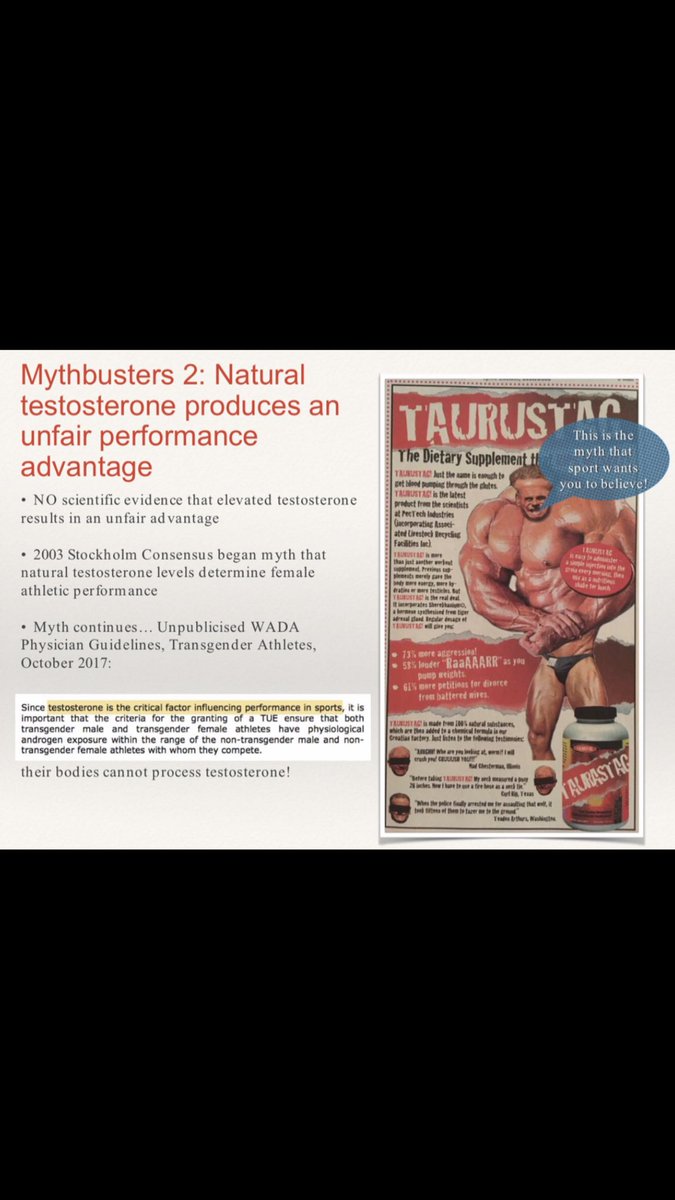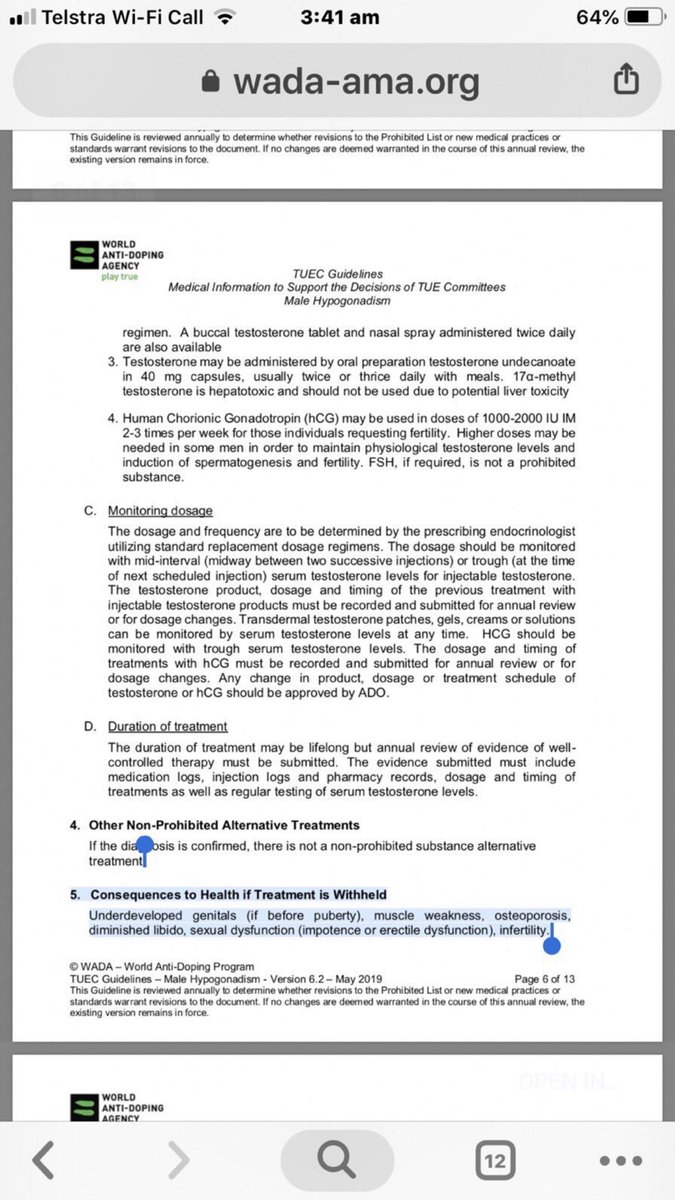XY trans female athletes need to maintain a testosterone level that is higher than the IOC ‘normal’ male range, i.e. the 10nmol/L limit under which XY trans women must fall in order to compete, just to maintain normal health.
https://www.sportsintegrityinitiative.com/sports-gender-policies-an-affront-to-human-rights/">https://www.sportsintegrityinitiative.com/sports-ge... https://twitter.com/KirstiMiller30/status/1368947764357328896">https://twitter.com/KirstiMil...
https://www.sportsintegrityinitiative.com/sports-gender-policies-an-affront-to-human-rights/">https://www.sportsintegrityinitiative.com/sports-ge... https://twitter.com/KirstiMiller30/status/1368947764357328896">https://twitter.com/KirstiMil...
Worley’s case & the @iocmedia following recycled policy.
Kristen Worley was the first athlete in Olympic sport and world cycling to be tested under the IOC’s 2003 new policy for transgender athletes ’The Stockholm Consensus Guidelines.
1-
Kristen Worley was the first athlete in Olympic sport and world cycling to be tested under the IOC’s 2003 new policy for transgender athletes ’The Stockholm Consensus Guidelines.
1-
Worley is an XY male that has transitioned to become an XY female. In the winter of 2009, after transitioning from male to female, Worley applied for a therapeutic use exemption (TUE) to use synthetic testosterone, based on hypogonadism secondary to gonadectomy.
2-
2-
She had previously asked Cycling Canada if she was eligible to compete, after the International Olympic Committee (IOC) released the 2003 Stockholm Consensus.
3-
3-
Worley was the first athlete in Olympic sport & @UCI_cycling to be tested under the IOC’s new policy. It mandated ‘that individuals undergoing sex reassignment from male to female after puberty (and the converse) be eligible for participation in F or M competitions,...
4-
4-
respectively, under the following conditions:
Surgical anatomical changes have been completed, including external genitalia changes and gonadectomy
• Legal recognition of their assigned sex has been conferred by the appropriate official authorities
5-
Surgical anatomical changes have been completed, including external genitalia changes and gonadectomy
• Legal recognition of their assigned sex has been conferred by the appropriate official authorities
5-
• Hormonal therapy appropriate for the assigned sex has been administered in a verifiable manner and for a sufficient length of time to minimise gender-related advantages in sport competitions’.
6-
6-
Over the next 3yrs, Worley & her medical team were repeatedly asked to provide medical information to support the requested TUE. She eventually withdrew from cycling competition in early 2009..
7-
7-
as she had found that the levels of synthetic testosterone she was permitted to take under the TUE were not enough to support her basic health.
8-
8-
“My TUE took ten months to grant”, explains Worley. “It should have taken less than three weeks. I was gender tested all over again. They asked me questions and requested personal information that far exceeded the requirements for a TUE.
9-
9-
Once receiving my TUE, the Canadian Centre for Ethics in Sport (CCES) required me to be tested every two months, abrogating World Anti-Doping Agency (WADA) standards of a maximum of two tests per year.
10-
10-
This kept me in a severe post-menopausal state, affecting my health and – inevitably – drastically affected my ability to train and maintain any form of adequate health to participle in elite cycling.”
11-
11-
’Chromosomes & science’
As previously mentioned, Worley was born as an XY male that has transitioned to become an XY female, because of converging cross-gender issues.
12-
As previously mentioned, Worley was born as an XY male that has transitioned to become an XY female, because of converging cross-gender issues.
12-
There are a number of different possible chromosome combinations that fall within the binary definition of ‘male’ and ‘female’. However, whilst you can change your sex, you cannot currently change the make up of your chromosomes.
13-
13-
“The IOC simply assumed that somebody born XY male transitioning to XY female would have a performance advantage over somebody who is born XX female”, explains Worley.
14-
14-
“There is no scientific research to support this. Neither the IOC, WADA, not the UCI have ever been able to provide evidence supporting their policy.”
15-
15-
The reason that sport assumed that XY females would have an advantage is down to testosterone. Elevating testosterone above the body’s natural (endogenous) level is judged to be performance-
16-
16-
enhancing, as it is thought to allow the athlete to build more muscle than their natural body would ordinary produce.
17-
17-
This is why administration of external (exogenous) testosterone is banned. However, there is no evidence that allowing an XY female to take synthetic testosterone to...
18-
18-
maintain the natural levels of endogenous testosterone that their gonadectomy (removal of testicles) has removed offers any performance advantage at all.
19-
19-
At this point, it is important to point out that T is not exclusively a male hormone. It is produced by both males and females in the testicles & ovaries (& also in the adrenal glands), however males need to produce it in higher quantities as they have XY androgen receptors.
20-
20-
XX androgen receptors are highly sensitive to testosterone, requiring much less T to equate the same level of health. However, both male & female elite athletes also produce T in higher quantities than the ‘normal’ population, &...
21-
21-
there is also a significant amount of overlap between testosterone levels in male and female elite athletes.
22-
22-
The maintenance of endogenous T levels is essential to basic health in both men & women. An XY male who transitions to XY female has had their major source of endogenous T (the testicles) taken away, so needs to take synthetic T in order to maintain basic health.
23-
23-
The US University of Rochester’s online medical library states that the normal ‘male’ range for testosterone is between 9.7nmol/l and 38.1nmol/l; and between 0.5nmol/l and 2.4nmol/l for ‘females’.
24-
https://www.urmc.rochester.edu/encyclopedia/content.aspx?ContentTypeID=167&ContentID=testosterone_total">https://www.urmc.rochester.edu/encyclope...
24-
https://www.urmc.rochester.edu/encyclopedia/content.aspx?ContentTypeID=167&ContentID=testosterone_total">https://www.urmc.rochester.edu/encyclope...
The US government’s National Library of Medicine agrees with the University of Rochester’s ranges with regards to ‘women’, but puts normal ‘male’ levels at between 10.4 nmol/l and 34.7nmol/l.
25- https://medlineplus.gov/ency/article/003707.htm">https://medlineplus.gov/ency/arti...
25- https://medlineplus.gov/ency/article/003707.htm">https://medlineplus.gov/ency/arti...
So individuals with XY chromosomes need a higher level of testosterone those with XX chromosomes to maintain basic health, due to their androgen receptor response.
26-
26-
As these analyses show, these levels can vary with age, but also due to occupation.
27- http://www.healthline.com/health/low-testosterone/testosterone-levels-by-age%23Adolescence3">https://www.healthline.com/health/lo...
27- http://www.healthline.com/health/low-testosterone/testosterone-levels-by-age%23Adolescence3">https://www.healthline.com/health/lo...
A 2014 study, ‘Endocrine profiles in 693 elite athletes in the post-competition setting’, found that 16.5% of the ‘male’ athletes had low testosterone levels, and 13.7% of the ‘females’ had high T levels, ‘with complete overlap between the sexes’.
28- http://www.ncbi.nlm.nih.gov/pubmed/24593684 ">https://www.ncbi.nlm.nih.gov/pubmed/24...
28- http://www.ncbi.nlm.nih.gov/pubmed/24593684 ">https://www.ncbi.nlm.nih.gov/pubmed/24...
The report concluded: ‘The IOC definition of a woman as one who has a ‘normal’ testosterone level is untenable’. In other words, elite athletes have testosterone levels that differ widely from those that might be considered ‘normal’ in the general public population.
29-
29-
We know that the T levels of high-performance female athletes go up from years of competing that this makes conception during competition or after retirement very hard, until those bodies come back to their natural state to be able to conceive a child,this very common.
30-
30-
We also know that an XY chromosome body takes six to 10 times the level of testosterone to equate the same levels of ‘health’ as somebody who is XX. This is completely separate to the body’s sex.
31-
31-
The problem has been that sport failed to realise that XY women continue to need XY levels of testosterone in order to maintain basic health following the transition.
32-
32-
Instead, it required & continues to require XY females to peg their testosterone levels to the much lower XX female levels, due to the myth that XY females would enjoy a performance advantage due to their extra endogenous testosterone.
33-
33-
In effect, sport was blinded by its history with exogenous testosterone, which has historically been used to enhance performance. This requirement to drop their natural, endogenous testosterone levels to XX female levels is what has physically harmed Worley, myself & others.
34-
34-
“This is where everybody got it wrong and continues to get it wrong”, explains Worley. “We are the only athletes in the world that can medically illustrate, physiologically, how the body breaks down over time and what happens to the human physiology...
35-
35-
when testosterone values get down to a certain level or is removed, and the body is no longer able to generate any hormones. For all other athletes that have been discussed in this space, their testosterone levels are their ‘normal’, and they are healthy.”
36-
36-
Worley’s TUE required her to keep her testosterone levels below those that were required by her XY body. The amount of testosterone permitted by her TUE were set below the average range for XX females at 0.5nmol/L,
37-
37-
even though the normal testosterone range for non-athletic XX females is 0.52nmol/L to 5.6nmol/L. This induced ‘complete hormone deprivation’ in Worley.
38-
38-
Testosterone has over 200 different functions in the human body, and its removal caused Worley a number of serious health complications, as Sports Integrity Initiative has reported.
39-
https://www.sportsintegrityinitiative.com/sports-gender-policies-an-affront-to-human-rights/">https://www.sportsintegrityinitiative.com/sports-ge...
39-
https://www.sportsintegrityinitiative.com/sports-gender-policies-an-affront-to-human-rights/">https://www.sportsintegrityinitiative.com/sports-ge...
For example, as well as removing the body’s ability to regulate itself and inducting menopause, Worley endured complete muscle atrophy (failure of muscle development and recovery), making sport impossible.
40-
40-
Far from removing the competitive advantage that sport claimed Worley held, sport’s regulations removed her ability to compete in sport completely, and damaged her health. And she is far from alone.
41- https://www.facebook.com/1887249791300837/posts/5907726635919779/?vh=e&extid=0">https://www.facebook.com/188724979...
41- https://www.facebook.com/1887249791300837/posts/5907726635919779/?vh=e&extid=0">https://www.facebook.com/188724979...
The XY females, when they transition, are the only ones that are put into spontaneous menopause. This has over 24 different complications concerning the human physiology. When an athlete goes down to zero, the impact is massive.
42-
42-
Kristen Worley, ”I can tell you that at 9.6nmol/L, I go into spontaneous menopause. The value of 10nmol/L, which the rules are suggesting, is impossible. It’s like comparing apples to oranges.”
43-43
43-43
@threadreaderapp please unroll

 Read on Twitter
Read on Twitter